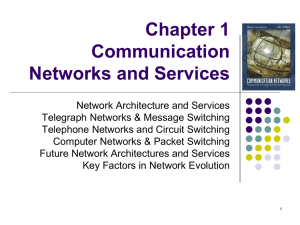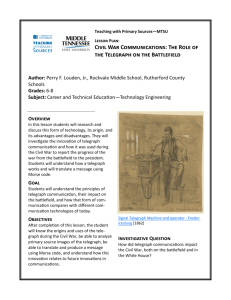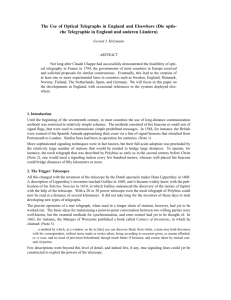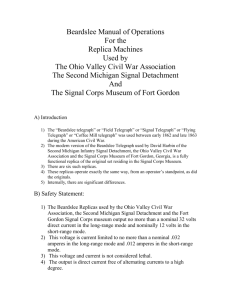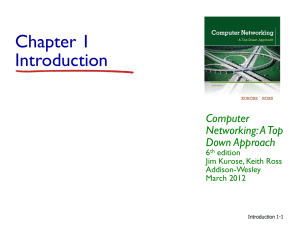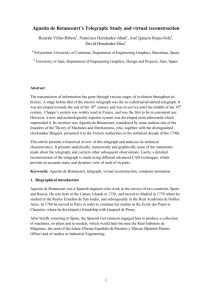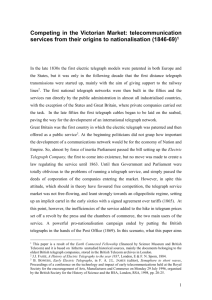426Introduction
advertisement
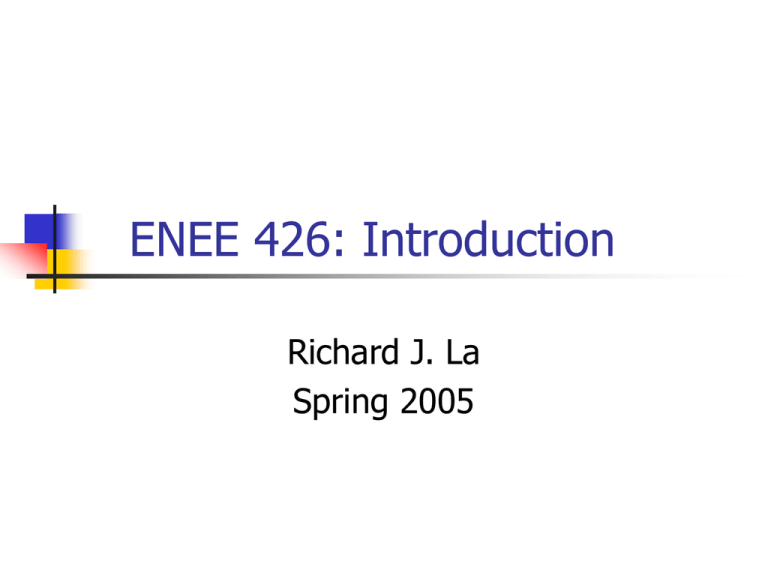
ENEE 426: Introduction Richard J. La Spring 2005 What is a Communication Network? Communication network – a set of interconnected resources that support information transfer between geographically distributed users Main function or service is “transfer of information” over shared communication resources Examples Telegraph networks (message) Telephone networks (voice) Computer networks (data) History of Communication Networks – Telegraph 1. Telegraph network – transmission of text messages over long distances 1837 Samuel B. Morse demonstrated a practical telegraph that provided the basis for telegram service (most successful version) Morse code – long and short pulses e.g. A = , B= Precursor of modern digital communication system Led to development of codes (and information theory) History of Communication Networks - Telegraph 1. Telegraph network (cont’d) Routing of a message Message or telegram arrives at a telegraph station An operator makes a “routing” decision based on the destination “address” telegraph station telegraph station Store-andforward Message Switching telegraph station History of Communication Networks - Telephone 2. Telephone network Telephone developed in 1876 by Alexander Graham Bell Used analog transmission system Requires setting up a connection before transfer of information can take place (called “circuit switching”) “connection-oriented” Reservation of resources Dedicated end-to-end connection Routing decision made when the path is set up History of Communication Networks - Telephone 2. Telephone network (cont’d) With transition to digital transmission and wide-spread user of computers for control, a separate “signaling network” is introduced Enables new services e.g., 800 number services, call forwarding, voicemail, etc. History of Communication Networks – Computer Network 3. Evolution from telephone networks to data networks to the Internet 1960s – expensive mainframes were time shared by many users Tree-topology terminal-oriented networks With emergence of more intelligent personal computers, dumb terminals were replaced by intelligent terminals and it became necessary to develop networks more flexible connecting many computers More complex protocols and network topology History of Communication Networks – Computer Network 3. ARPANET Wanted to develop a resilient and robust communication network that can tolerate link/node failures (courtesy of Cold War!) Kleinrock advocates the use of “packet-switching” over “circuitswitching” for reliability and efficiency (1961) Leads to ARPANET project (1969) Beginning of the Internet SRI UCSB UTAH UCLA – first Interface Message Processor (IMP) History of Communication Networks – Computer Network 3. ARPANET (cont’d) Host-host protocol Host-IMP protocol Host Source IMP to destination IMP protocol Subnet IMP-IMP protocol IMP History of Communication Networks – Computer Network 3. NSFNET (1986) Created to provide access to NSF-sponsored supercomputing centers Serve as a primary backbone linking together regional networks Used to connect regional networks Restriction on commercial use lifted in 1991 Privatized and decommissioned in 1995 Private service providers provide backbone service History of Communication Networks – Computer Network Local ISP Regional ISP NSP B Private Peering NAP NSP A Regional ISP Local ISP NAP History of Communication Networks – Computer Network Current Internet Hierarchical structure End systems connected to local Internet service providers (ISPs) through access networks e.g. local area network within a company or university, a dial telephone line with a modem, or a high-speed cable-based or phone-based access network Local ISPs in turn connected to regional ISPs Regional ISPs connected to national service providers (NSPs) Can directly connect to network access points (NAPs) as well History of Communication Networks – Computer Network National Service Providers (NSPs) Form independent backbone networks that span North American (and extend abroad as well) internetMCI, SprintLink, etc. Links ranging from 1.5 Mbps to tera bps Provides hubs that interconnect its links and at which regional ISPs can tap into the NSP NSPs interconnected at switching centers, called network access points (NAPs) Many NAPs run by regional Bell operating companies (RBOCs) Message switching, packet switching, & circuit-switching Circuit-switched network Resources needed along a path (buffers, link bandwidth) to provide for communication between the end systems reserved for the duration of the system at the set-up phase E.g. telephone network Message or packet-switched network Resources not reserved Messages or packets use the resource on demand May need to wait due to lack of reservation Queueing delay E.g. telegraph network, computer networks Telephone network 10 Regional Offices (fully connected) Sectional Offices Primary Offices Toll Offices End Offices Telephone network Resource Reserved on all links Message-switch vs. packetswitching In packet-switching Message may need to be segmented into smaller “packets” and reassembled at the edge nodes Advantages: Smaller end-to-end delay Smaller probability of packet error Disadvantage: Larger overhead – source address, destination address, etc. need to padded to the packets Message-switch vs. packetswitching 7.5 Mbits long message 1.5 Mbps 1.5 Mbps 1.5 Mbps 0 5 10 15 Message-switch vs. packetswitching 7.5 Mbits long message -> segmented into 5,000 1.5 kbits packets 1.5 Mbps 1.5 Mbps 1.5 Mbps 0 5 5.0002 Connection-oriented vs. Connectionless Connection-oriented Telephone network Connection-oriented data connection (TCP) A “circuit” must be established before a conversation can start Three-way handshake Connectionless Connectionless data connection (UDP) No set-up phase Telegraph network


